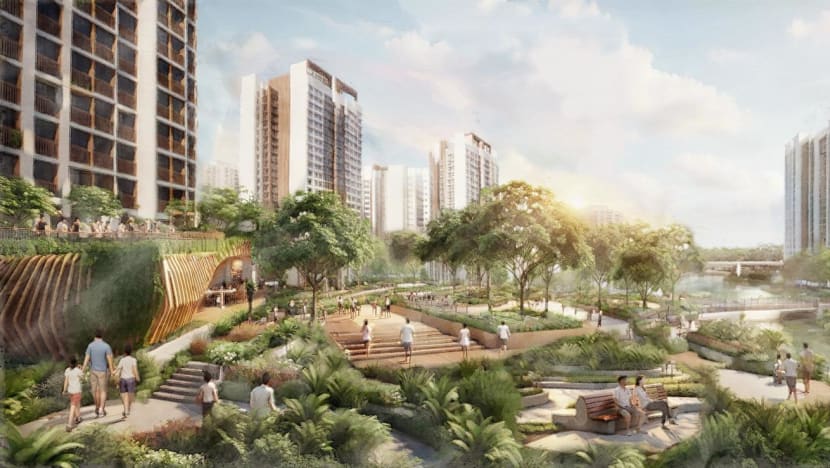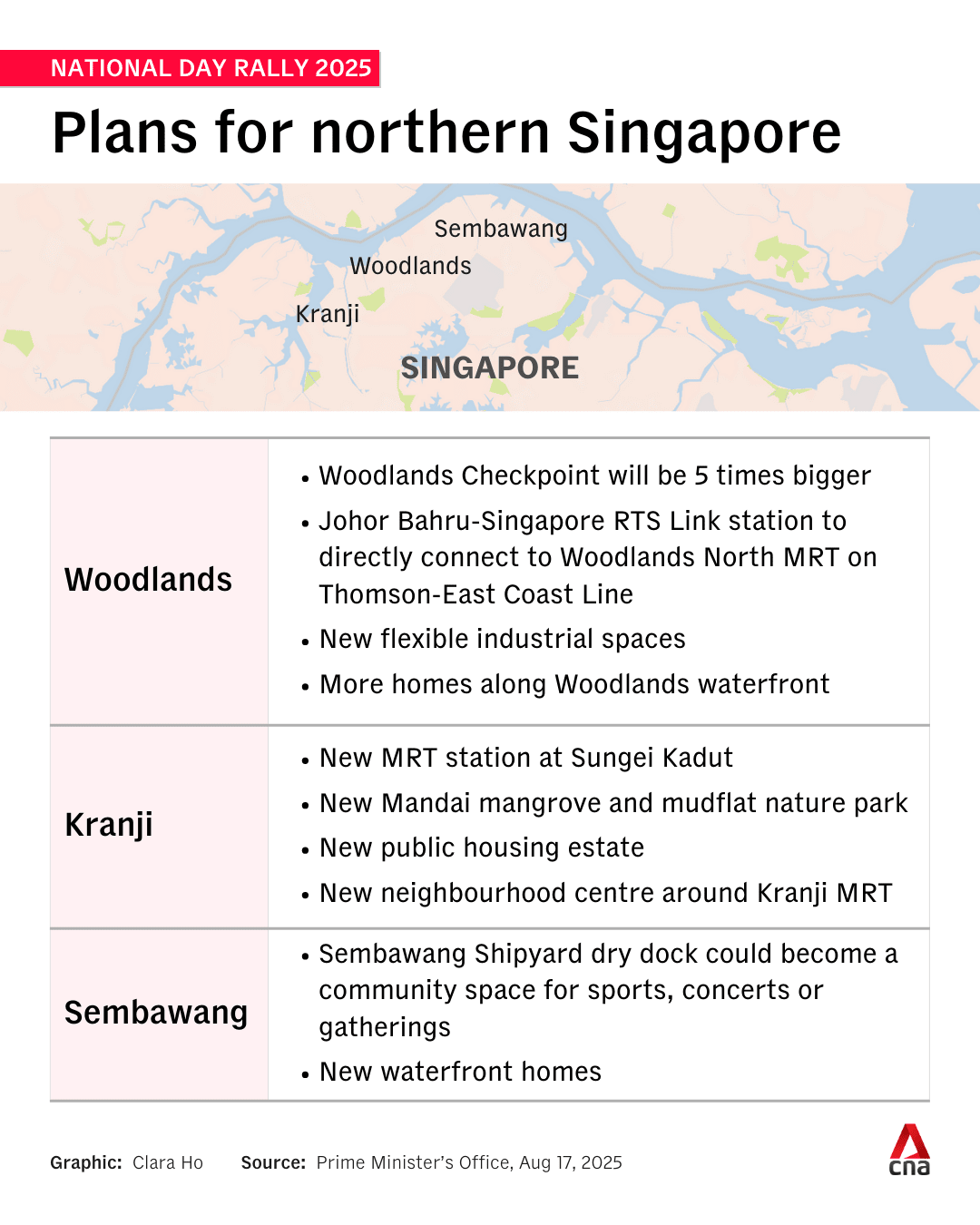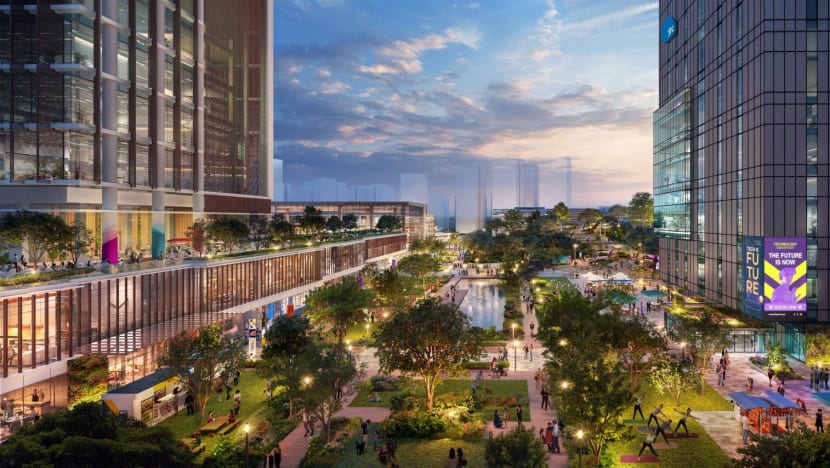Better connectivity, amenities needed to complement new housing plans for northern Singapore: Experts
Can Kranji and Sembawang shake off perceptions of being "ulu"? Prime Minister Lawrence Wong said in his National Day Rally that these areas will be transformed into vibrant new towns.

The new housing development in Kranji will combine urban living with the site's natural heritage. (Image: Urban Redevelopment Authority)

This audio is generated by an AI tool.
SINGAPORE: As part of efforts to rejuvenate northern Singapore, better transport options, more amenities and unique plans for smaller towns will be needed alongside new homes, experts said, following Prime Minister Lawrence Wong's National Day Rally announcement.
In his speech on Sunday (Aug 17), Mr Wong touched on development plans for three areas - Kranji, Sembawang and Woodlands - noting how some people have described the north as being “ulu” or remote.
That perception may well change.
The space occupied by Sembawang Shipyard, for instance, can become a “new vibrant waterfront destination” with homes, dining and recreation, Mr Wong said. The 86ha site is about three times the size of Ang Mo Kio town, and shipyard operations will wind down in 2028.
In Kranji, a new public housing estate is set to be developed at the former Singapore Racecourse site. To be ready in about 10 years, the 130ha site will likely have 14,000 new homes and amenities, including a neighbourhood centre around Kranji MRT station.
Experts said the government’s shift in focus to the north is hardly surprising following earlier efforts to develop other new towns, such as Punggol and Tengah.
“With the east and the west largely developed, the north is now, if I can call it, the next frontier, where we have a lot of space to redevelop. So naturally, it is time to direct attention and resources to building up this part of Singapore,” said Huttons Asia’s senior director of data analytics Lee Sze Teck.
Orchid Country Club near Mandai is another site that is prime for redevelopment, said Mr Lee, who estimates that more than 10,000 private and public homes could be built there.
It is one of six golf courses that will not have their leases renewed upon expiry over the next 10 years, and has been rezoned for housing in the latest land-use masterplan.

CONNECTIVITY IS KEY
Given that Singapore is a small country that is fairly developed, the north is hardly “ulu” or desolate. Experts CNA spoke to cited Yishun, Khatib and Woodlands as examples of decades-old housing estates with their own amenities and MRT stations.
The sense of remoteness is hence a “perception” partly due to the longer commute time to the city centre, compared with other regional centres such as Tampines and Jurong East, said Mr Nicholas Mak, chief research officer at property search portal Mogul.sg.
More can therefore be done, experts said.
There are already efforts to improve connectivity, such as the Thomson East-Coast Line, which reduces the time taken to travel from Woodlands to town.
Plans are underway for an MRT station at Sungei Kadut, which will be an interchange connecting the North-South and Downtown MRT lines. This station – part of the Downtown Line extension project – is expected to open by 2035.
“This will be a game-changer to provide better connectivity in the Sungei Kadut and Kranji areas, and it looks like it has been timed to be ready together with the new homes (in Kranji),” said Singapore University of Technology and Design’s (SUTD) Associate Professor of Practice Calvin Chua.
Details of the new Seletar MRT line – one of two new rail lines under study by the authorities – will also be keenly awaited.
First announced in March, the proposed Seletar Line could serve areas like Woodlands, Sembawang, Sengkang West, Serangoon North, Kallang and the Greater Southern Waterfront.
Residents in parts of Yishun and Sembawang that are currently far away from the North-South Line – the only MRT line serving these northern neighbourhoods – are likely to benefit from the planned Seletar Line, said Associate Professor of Economics at Singapore University of Social Sciences (SUSS) Walter Theseira.
Mr Mak suggested having more accessible rental transport options, such as electric cars with various pick-up or drop-off points.
On top of last-mile mobility options, Assoc Prof Chua said walkways could also be better designed to help bridge the gap between public transportation hubs and individual destinations.
He cited the example of Chencharu, the new housing estate under development with Khatib MRT station nearby.
“Now, all you get is a cycling path and walkway underneath the MRT tracks. More can definitely be done to improve the walkability here,” said Assoc Prof Chua, who is from SUTD’s architecture and sustainable design faculty.
“If designed well, for example, a sheltered area lined with shops and amenities, it can be quite a nice walk to the MRT station.”
WOODLANDS AS A REGIONAL BUSINESS CENTRE
Solving the issue of connectivity is not just about ensuring sufficient capacity to take people into the central parts of Singapore, but also about channelling “flows in the opposite or other directions”, said SUSS' Assoc Prof Theseira.
“Ideally, besides building more homes, what you also want to have is more economic activities to be centred around these homes, so that people who are living there can also work and play without having to travel all the way into the city centre or other parts of Singapore,” he said.
Echoing that, Professor Sing Tien Foo from the National University of Singapore (NUS) said: “Singapore will need to improve connectivity, which is an important strategy to support and encourage decentralisation, thereby helping to ease pressure in the CBD and central areas.”

To that end, the government has been actively developing Woodlands as a regional centre, as part of its “decentralisation strategy” to create economic areas beyond the city centre and bring jobs closer to homes.
This comprises two distinct precincts – Woodlands Central and Woodlands North Coast – with over 700,000 sqm of new commercial space and more than 100ha of developable land for future expansion.
The Johor-Singapore Special Economic Zone is poised to further enhance the role of Woodlands as a key economic node, said Professor Sing, who is provost's chair professor of real estate at the NUS Business School.
The decentralisation strategy through the Woodland regional centre could also be enhanced with the Johor Bahru-Singapore Rapid Transit System Link, which is expected to start operations by the end of next year, he added.

To foster the growth of new neighbourhoods, it is also important to “create anchor nodes and institutions that can generate specific social-economic profiles”, said SUTD’s Assoc Prof Chua, citing the example of the Punggol Digital District in Punggol Coast.
“It is one thing to create nicer public spaces, but it is also crucial to create an anchor profile or institution where people would be drawn.”
For instance, at the Sembawang Shipyard site, its existing large warehouses with high ceilings could be turned into innovation or education spaces with a focus on agri-food, leaning into the plans for an agri-food innovation park in the nearby Sungei Kadut, he suggested.
More amenities might also be needed, such as shopping malls, affordable dining options, medical facilities and schools, said Ms Christine Sun, chief researcher and strategist at OrangeTee-Realion Group.
Authorities could replicate what it has done for Tengah – by shifting a reputable or established school to attract more young couples to settle in the new town, she said, referencing the impending move of Anglo-Chinese School (Primary) from its current Barker Road location to Tengah in 2030.















